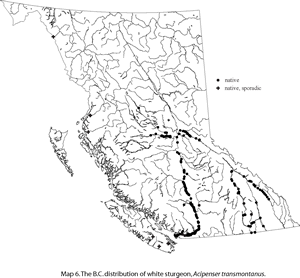Dorsal spines (total): 0; Dorsal soft rays (total): 44 - 48; Anal soft rays: 28 - 31. Distinguished by the 2 rows of 4 to 8 bony plates on a midventral line between the anus and anal fin, and about 45 rays in the dorsal fin. Gray or brownish above, paler below; fins gray.
White Sturgeon
Family: Acipenseridae
Introduction
|
Species Information
Biology
|
Distribution
|
BC Distribution and Notes The white sturgeon is in serious decline in the Nechako, upper Columbia, and Kootenay rivers. The Kootenay population is genetically distinctive. The apparent head shape differences between the Fraser populations above and below the Fraser Canyon need to be quantified and clarified. Source: Information provided by Don McPhail for E-Fauna BC. Global Distribution Eastern Pacific: Alaska Bay to Monterey, California, USA. Landlocked in Columbia River drainage, Montana, and perhaps Lake Shasta in California, USA. Source: FishBase. Page, L.M. and B.M. Burr 1991 A field guide to freshwater fishes of North America north of Mexico. Houghton Mifflin Company, Boston. |
Status Information
BC Ministry of Environment: BC Species and Ecosystems Explorer--the authoritative source for conservation information in British Columbia. |
Taxonomic and Nomenclatural Links
Additional Range and Status Information Links
Additional Photo Sources
Species References
|
British Columbia Conservation Data Centre. 2010. Comprehensive Report for White Sturgeon. Species and Ecosystem Explorer. Online database. BC Ministry of Environment, Victoria. Page, L.M. and B.M. Burr 1991 A field guide to freshwater fishes of North America north of Mexico. Houghton Mifflin Company, Boston. 432 p. McPhail, J. D. 2007. The Freshwater Fishes of British Columbia. University of Alberta Press, Edmonton.
Scott, W.B. and E.J. Crossman. 1973. Freshwater fishes of Canada. Bulletin 184. Fisheries Research Board of Canada. Ottawa. |
